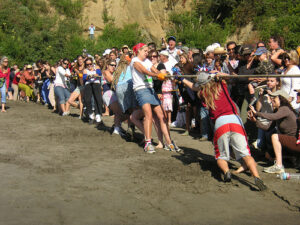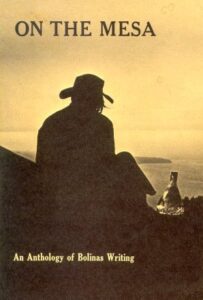I’ve been enjoying time back in San Francisco and, away from work, I continue to explore the sublime coastal zones of Marin county. This is territory where surfers, poets, artists, writers, musicians, off-the-grid idealists and the very rich hang out, as evidenced by ageing surf vans parked next to new BMWs and where houses sell for between $1 million and $20 million.
Last Friday I headed to Stinson Beach (30 miles north of San Francisco) for lunch with my new friend, Brita Dorst Gemmo, who owns Stinson Beach Gallery and whose latest exhibition attracted hundreds of people to the opening event. We were in the courtyard, talking about Brita’s recent trip to Australia, when Claudia Chapline from the Claudia Chapline Gallery walked in. She was headed to Bolinas.
“I’ve wanted to go to Bolinas for a long time now,” I said. “Well, would you like to come with me?” Claudia asked. “Yes, I’d love to!”
Claudia was in her late 70s and she was just about to publish a new book of poems after her last one had enjoyed a great reception. She had a wonderful zest for life; both she and her husband were painters, painting every day and embracing love and beauty in all its forms.
 I climbed into Claudia’s car and we headed off to the town, a 20 minute drive away ,and that some locals call ‘Bo Bo’. If it had been low tide, I could have floated across the water from Stinson Beach to Bolinas. A day earlier, on the 4th of July, the two towns had engaged in their annual giant Bolinas-Stinson Tug of War across the water with teams competing for the honors – this year
I climbed into Claudia’s car and we headed off to the town, a 20 minute drive away ,and that some locals call ‘Bo Bo’. If it had been low tide, I could have floated across the water from Stinson Beach to Bolinas. A day earlier, on the 4th of July, the two towns had engaged in their annual giant Bolinas-Stinson Tug of War across the water with teams competing for the honors – this year
Bolinas won.
One of the characteristics of the Bolinas community is they don’t want to see it changed by a tourist onslaught. Their way of ensuring that this doesn’t happen was to take down the road sign on Highway 1 indicating the Bolinas turnoff so that tourists couldn’t easily find their way. And it’s true! There are no signs to Bolinas. Instead, there’s beautiful rolling country and the close proximity of the Bolinas Lagoon that remains home to terns, herons, egrets, pelicans, cormorants, loons, kingfishers, seals and many other species.
Claudia parked the car and we headed down the main street. I looked across the street to see an assortment of trucks parked. Each truck had a sofa placed on its flatbed with a group of guys lounging on the sofas and providing a running commentary on the passing foot traffic.
 Next to the Bolinas People’s Store (food co-op) was The Free Box, where clothes that were free for anyone to take were housed in a shed adorned with rainbows, while the nearby bookstore had a donation honor system based on a self-assessment of the book’s worth. Claudia and I stopped into the General Store which was wallpapered with photos of babies born to locals with the kind of countercultural names that made me smile. It won’t be surprising, then, to know that Bolinas hosts an annual Sun Festival to welcome newborn babies. For the last 20 years this Baby Blessing Ceremony has become a key celebration for the local community and there’s even a Renewal ritual where the new babies bless the community.
Next to the Bolinas People’s Store (food co-op) was The Free Box, where clothes that were free for anyone to take were housed in a shed adorned with rainbows, while the nearby bookstore had a donation honor system based on a self-assessment of the book’s worth. Claudia and I stopped into the General Store which was wallpapered with photos of babies born to locals with the kind of countercultural names that made me smile. It won’t be surprising, then, to know that Bolinas hosts an annual Sun Festival to welcome newborn babies. For the last 20 years this Baby Blessing Ceremony has become a key celebration for the local community and there’s even a Renewal ritual where the new babies bless the community.
Claudia and I walked on to the Bolinas Museum where it seemed half the town was gathered for the latest exhibition and to celebrate raising the funds to cover the cost of building restorations. Under the leadership of the Museum’s previous executive director, the Bolinas community raised the capital funds to buy the building so that they could retain the town’s vibrant arts and cultural community and celebrate it with regular exhibitions and events. “The town is filled with talented musicians,” Claudia told me – and so it seemed as I listened to a gifted guitarist play from a loft above the community gathering in the Museum courtyard.
Later we headed for the local beach and as Claudia parked in front of it, she declared, “Here we are at Brighton Beach!” I laughed out loud. Here we were in Bolinas, with locals fiercely intent on retaining the identity of the place, and yet we had Brighton Beach, as English a seaside name as one could imagine.

There were plenty of dogs on the beach – “more dogs than people” observed one visitor – and yet it also gave the beach the friendly warmth that bounding dogs provide. There were surfers, swimmers, shell collectors and people snoozing. There’s myth too. Legend has it that a woman rides her horse along the shore break in Bolinas.
Bolinas’ beaches were hit hard by the 1971 San Francisco Bay oil spill, where hundreds of birds were killed and hundreds more were contaminated. Thousands of people poured into Bolinas to help scrub cormorants, gulls, grebes and loons that had been coated in oil. During that time, people in the town realized how fragile the ecosystem was, and that they were not protected from the wider world.
Many people who came for the cleanup decided to stay. “Educated, activist, oriented toward the countercultural, they understood the political process,” the history said. In late 1971, their candidates gained a majority on the district’s board and almost immediately imposed a moratorium which placed a prohibition upon the granting of new water permits, severely limiting any potential growth. Only locals with a water meter had the right to hook up to the municipal water supply, which comes from the Arroyo Honda, a small, spring-fed creek about five miles north of town. This means that if you’ve bought land in the area then you have to buy a house in order to gain its water meter or you have to wait for one to be auctioned. The last water meter auctioned cost $310,000.
Poet and writer, Kevin Opstedal, described the scene at that time.
“In the late sixties a significant number of poets and artists were among (those) that made their way to Bolinas. It was a secluded hideaway and a place of great physical beauty. A scruffy little surf ghetto tucked away behind coastal hills and walls of Douglas fir and eucalyptus. The downtown area consisted of about two blocks on Wharf Road. Smiley’s Bar and Pepper’s (the general store) were the highlights.
To the north of downtown, up on the mesa, was a scattering of rough little houses settled in among eucalyptus, cypress, and Monterey pines. Giant cascades of nasturtiums spilling over wooden fences. From the mesa bluffs, towering over Duxbury Reef, you could hear the tide movements carried up on the almost constant sea breeze. It was on the mesa that the majority of poets made their homes.”
Opstedal also said ‘Not having that academic presence made for a more visionary, “utopian” atmosphere—the politics of the place was so important and interesting. It wasn’t simply a hippie alternative situation, an easy comfortable scene for artists, but a rigorous place—involving commitment.’
“The essential humanity of the town was remarkable. It was a way of life,” said McNaughton.” “Coming to Bolinas and getting involved in politics saved my life,” MacAdams said. “I understood that …you could start from the ground up, you know, make sure the water was right.”
It wasn’t just the politics of place, it was also the poetics of space that captivated. So too the names and descriptions that accompanied new gigs in the community such as for the Bolinas Poets’ Orchestra where people were encouraged to experience ‘a strange blast of sunshine and moon music.’.
 Bill Berkson began publishing Big Sky magazine at about this same time. Featuring primarily works by Bolinas writers, Big Sky was one of the liveliest little magazines of its time. There was also a community printing press, called simply The Press, which supported many local publishing ventures from community newsletters and ecological tracts to poetry.
Bill Berkson began publishing Big Sky magazine at about this same time. Featuring primarily works by Bolinas writers, Big Sky was one of the liveliest little magazines of its time. There was also a community printing press, called simply The Press, which supported many local publishing ventures from community newsletters and ecological tracts to poetry.
An anthology of Bolinas poets published by City Lights called “On the Mesa” celebrated these poets that ‘have come together with new Western and mystic elements at the unpaved crossroads of Bolinas.’
I was entranced by the culture and history of the place and now it was time to go home. Claudia and I made a final stop on our way back to Stinson Beach, to a roadside stand with luscious organic food and vegetables and a riot of flowers, and yet another honor box with suggested purchase prices.
I was happy. I’d bought a boogie board while we’d been out and now I was feeling like a regular California Girl, catching the sea-breeze and with the promise of surf, poetry, music and art when next I returned. And maybe I could learn something about starting my own small printing press too.
This is Bolinas, California.
The home of the poets.
– Aram Saroyan
Jane Sloane – San Francisco